PEACEFUL SUMMER’S EVE
Ellen Segal of Port Jefferson snapped this serene photo at Long Beach in Nissequogue just moments before the sun set on Aug. 9.
Send your Photo of the Week to leisure@tbrnewspapers.com
PEACEFUL SUMMER’S EVE
Ellen Segal of Port Jefferson snapped this serene photo at Long Beach in Nissequogue just moments before the sun set on Aug. 9.
Send your Photo of the Week to leisure@tbrnewspapers.com
Sunrise Wind official speaks of ‘underutilized facilities’ in Port Jeff

Imagine a field, not on land but on the open ocean — not of green plants topped with colorful flowers, but of huge, 800-foot towers topped with spinning, white wind blades.
That is what officials from two companies and the New York State Energy Research and Development Authority asked Brookhaven Town residents to envision. At a public meeting hosted at Town Hall Sept. 17. Plans are for two offshore wind projects, located off the East End and South Shore of Long Island. Eventually, the wind farms will provide close to 1,700 megawatts of energy to Long Island, powering 1 million homes and generating up 30 percent of New York’s power capacity by 2035, according to NYSERDA officials.
One offshore wind project, Sunrise Wind, a combined venture with U.S.-based Eversource and Denmark-based Ørsted, is of special interest to Brookhaven Town and the Village of Port Jefferson. The companies have announced its intent to use Port Jefferson Harbor as a headquarters and base of operations for not only this upcoming project, but for offshore wind across the Eastern Seaboard.
Ken Bowes, the vice president of offshore wind siting and permitting at Eversource, said they are currently working with local realtors, as suggested to them by Port Jefferson Mayor Margot Garant. The business is searching for warehouse and office space in the local area. He said they are looking for space in close proximity to the village, though finding a suitable location within the village boundaries will likely be difficult.
He said he expects around 50 full-time employees will work on the vessel the company uses to go out and provide maintenance and service the wind turbines, though they expect the project to supply 100 jobs over the planned 25-year lifespan of the turbines. These employees would stay on the vessel for weeks at a time before arriving back in Port Jeff, and he said the vessel should not interfere with the Port Jeff to Bridgeport ferry.

If the plans pan out, Bowes said its ambitions are for Port Jefferson to be the headquarters for all work done for their company’s wind projects on the Eastern Seaboard, including current projects off Rhode Island and Massachusetts.
“We may look to do this as a service for all of our projects and possibly for others as well,” he said. “We’ll see how that all unfolds.”
Sunrise Wind will encompass 110 wind turbines situated 30 miles off the coast of Montauk, and at full capacity will generate 880MW of electricity. Both projects, which include Empire Wind, are expected to be operational by 2024, according to current timelines.
Town Supervisor Ed Romaine (R) said they are in support of renewable energy projects but said there are numerous questions that still need answered about how the projects will impact people, especially in terms of how it will affect fishing communities and in its cost to the surrounding communities.
“We all need to have clean renewable power — I think it’s more urgent than ever,” he said. “There’s a promise of not only clean power but also a little bit of economic opportunity.”
Some major concerns have come from Long Island fishermen, who have said the planned wind projects could impact their business. Jennifer Garvey, the Long Island development manager at Ørsted, said there is no exclusion area for their project, and fishermen can get as close as they want to the turbines when fishing. Each turbine is planned to be spaced 1-mile apart east to west in a grid-like pattern, which, she said, will aid in navigation and in search and rescue operations.
In addition to the offshore wind projects, both Sunrise Wind and New York State say they plan to invest heavily in college-level training programs for people to work on offshore wind. Doreen Harris, vice president for large-scale renewables at NYSERDA, said the state has already invested around $20 million for an offshore wind training institute through the SUNY system. She described it as a hub-and-spokes model, where colleges and universities such as Stony Brook will contain centers for education and training in harnessing wind energy. For their part, Bowes said Sunrise Wind has already promised invested $10 million for a training program at Suffolk County Community College, though the college has not received any funds yet and details on the program remain sparse. The energy company vice president said they were still hashing out the details, adding more information will be available in the near future.
Bowes said they chose Port Jefferson because of its deepwater harbor and its existing amenities. He also said they chose it due to its currently “underutilized infrastructure,” though when asked if that indicated the
LIPA-owned Port Jefferson Power Station, he declined to say. He did not wish to speak about Sunrise Wind.

“I can say we are looking at sites that would be natural for [the project,]” he said.
The Port Jeff power plant, which recently settled in a tax certiorari agreement with the Town of Brookhaven over its tax assessments, has been running at low percentages for the past several years. It was only 11 percent in 2017, for example. In a previous Port Times article, LIPA said the reduction in taxes may help move the plant toward a clean energy recourse but has not provided more details on what that could entail.
The recently passed state Climate Leadership and Community Protection Act calls for a transition to a carbon-free electric grid for New York by 2040. A LIPA spokesperson previously told TBR News Media the Port Jeff power plant will be more than 70 years old by 2030. LIPA has already decommissioned fossil-fuel power plants in Far Rockaway and Glenwood Landing. LIPA has also said Sunrise Wind is key to transitioning toward the state engineered clean energy milestones.
Adrienne Esposito, director of the environmental advocacy group Citizens Campaign for the Environment said the best-case scenario would be Ørsted and Eversource using the power plant.
“Think about the symbolism of repurposing a fossil fuel plant and transform it to something that will help wind power. How great would that be?”
This story has been amended Sept. 19 to say Sunrise Wind has promised $10 million for SCCC has been promised but not yet received.
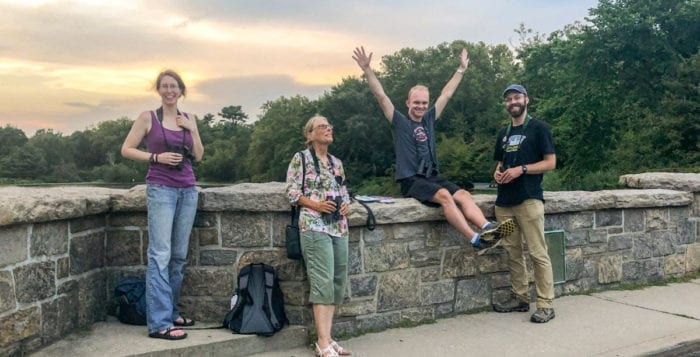
Calling all bird lovers!
Migration has begun! Join Four Harbors Audubon Society at Frank Melville Memorial Park’s Stone Bridge to witness the exciting annual migration of the most beloved members of the nightjar family — the common nighthawk. Migration might be any or all days through early October. Join them from 5:30 p.m. until dusk as they conduct the third annual nighthawk census, and enjoy the show! The Stone Bridge is located at One Old Field Road, Setauket. For more information, email [email protected].
EARL
Karen Silvestri of Melville snapped this photo of an egret that has been living in Oceanside for many years and is known to the locals as Earl. She writes, “Earl will let people photograph him without flying away. I used a zoom lens to capture this photo but for a bird of this species he was still close to me. Earl was about 20 feet away, which is surprisingly close for an egret, when I took this photo on July 27.”
Send your Photo of the Week to leisure@tbrnewspapers.com
After a decade delay and wringing of hands, the Mount Sinai Jetty project is going to start construction within a week as the end of summer closes in.
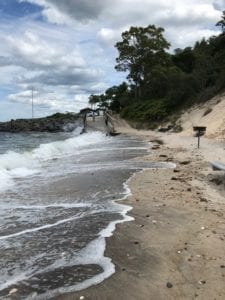
Ed Morris, the Brookhaven Town Parks & Recreation commissioner, said construction is ready to start the project within the week. The contractor Bay Shore-based H&L Contracting is already in the process of gathering supplies. Materials will be stored at the Cedar West Beach Parking lot, which is down the road of the main town beach parking lot.
“H&L will be starting up a staging area sometime in the next few days — [and will] be mobilizing everything,” he said.
H&L’s $7.4 million contract to rebuild the east and west jetties, which has been crumbled mess for close to a decade. The jetties rocks collapsed and submerged at the seaward ends during high tide, and lower than 4 feet in some places. Holes in the jetty have also caused erosion to surrounding bluffs and beachfronts. The western jetty has been of particular concern to neighboring Port Jefferson village and its beaches.
Matt Miner, Brookhaven Town chief of operations, said an outside engineering firm did an underwater review of the jetties, which confirmed that sand is slipping through it. The rocks that will be placed in the jetties will match the size as the ones currently used and will restore the structure’s integrity.
In addition, Melville-based surveying and engineering firm Nelson & Pope is being paid $86,000 for full-time construction inspection services.
The project is expected to be completed by the end of the year, with a finalization hopefully by spring, Morris said. Construction will be done on opposite sides of the inlet, which the commissioner noted, to allow boats through in both the on and off season.
The jetties are expected to increase in height and become slightly wider. The west jetty will extend slightly further south than the east jetty.
One element of the project that is still to be determined is the outcome of the sand sitting at the bottom of the inlet. Suffolk County has promised to dredge the sand from its bottom once the jetty project is concluded. Port Jefferson Village officials have been chomping at the bit looking to get sand back to repair its rapidly diminishing East Beach. Morris could not confirm where the sand would end up.
“Ideally, sand would be going on both sides of the jetty,” he said.
In the meantime, Port Jefferson officials have plans to piggyback the town’s contracts to aid their own beach restoration efforts.
Mayor Margot Garant said the village will be entering into contract with H&L to drop off materials at East Beach and to use the village’s East Beach parking as a staging area. She said it was still unclear how much of the parking lot they would be using. With the massive amount of rocks the company will be hauling, it could mean several trucks traveling down the steep driveway on a consistent basis.
“I don’t know to what degree they’re going to be using the east end parking lot as a staging area for some heavy equipment, maybe not at all, but it’s mostly for access,” Garant said.
As of Sept. 3, the village attorney was set to go over the details with the contractor.
Port Jefferson has plans of its own to revitalize its easternmost beachfront. The contract with H&L allowing them use of the beach will give them stone for use in rebuilding its cracked concrete access ramp. Plans are for a steel wall to cut back 200 feet tied into the hill along the country club property. The mayor said they originally looked at 356 linear feet to run along the tennis courts area, but New York State Department of Environmental Conservation restricted them to the 200.
However, the mayor said the state has promised to allow them to create a rock revetment wall around that tennis courts area to help offset erosion.
The village is still waiting on its permits from the DEC before going out to bid on those projects.
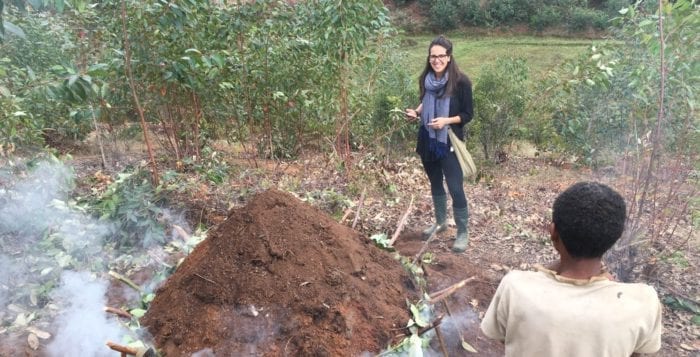
By Daniel Dunaief
BeLocal has progressed from the drawing board to the kitchen. The nonprofit group, which was started by the husband and wife team of Mickie and Jeff Nagel as well as data scientist Eric Bergerson, has been working to improve and enhance the lives of people living in Madagascar.
BeLocal, which started in 2016, has sent representatives, including Laurel Hollow resident Mickie Nagel and executive director Leila Esmailzada, to travel back and forth to the island nation off the southeast coast of the African continent.
Working with Stony Brook University students who identified and tried to come up with solutions for local challenges, BeLocal has focused its efforts on creating briquettes that use biomass instead of the current charcoal and hardwood, which not only produces smoke in Malagasy homes but also comes from cutting down trees necessary for the habitat and the wildlife it supports.

“In the summer of 2018 we figured out that we had something that works,” said Mickie Nagel. “We had all the agricultural waste and could turn it into fuel. Our goal is to start thinking about how to bring it into communities and into the daily lives” of people in Madagascar.
In January of this year, Esmailzada partnered up with Zee Rossi to introduce the new briquettes to residents of three villages, who were interested in the BeLocal process and offered feedback.
Rossi worked in Madagascar for three years as a part of the Agricultural Food Security Advisory Section of the Peace Corps, until he recently joined the staff at BeLocal.
At this point, BeLocal has helped create four working production sites for the briquettes, all of which are on the outskirts of the Ranomofana National Park, which Stony Brook Professor Patricia Wright helped inaugurate in 1991.
The biochar briquettes solve several problems simultaneously. For starters, they reduce the amount of hardwood Malagasy residents chop down to provide fuel for cooking. The biochar briquettes are made from agricultural waste, such as corn husks and cobs, rice stalks, leaves, small sticks and even unusable waste from the production of traditional charcoal.
The briquettes also produce less smoke in the homes of the Malagasy. At this point, BeLocal doesn’t have any data to compare the particulates in the air from the briquettes.
One of the current briquette makers is generating about 2,000 of the circular fuel cells per month. As a start-up effort, this could help with several families in the villages. Nagel estimates that it takes about 12 briquettes to cook a meal for a family of four. The families need to learn how to stoke the briquettes, which are slightly different from the cooking process with the charcoal and hardwood.
Esmailzada and Rossi had planned to return to Madagascar in July, where they hoped to understand how people are using these sources of energy.
Esmailzada has taught and workshopped with the Malagasy on how to make the briquettes. Since returning to the United States, where she recently completed a master’s program in public health with a focus on community health at Stony Brook University, she was eager to see how much progress has been made.
BeLocal has continued to refine the technique for creating these briquettes. Working across the border with Stony Brook graduate student Rob Myrick, Malagasy residents have tried to char the biomass in a barrel, instead of digging a pit.
“Hopefully there will be movement” with the barrel design, Nagel said.
Myrick is working on refining the airflow through the pit, which could enhance the briquette manufacturing process.
Myrick will “work on techniques [at Stony Brook] and [Rossi] will work on the process with the villagers over there,” Nagel explained in an email. Myrick has been “such a helpful and great addition to BeLocal.”
Esmailzada and Nagel are delighted that Rossi joined the BeLocal effort.
“It’s such a natural partnership,” Esmailzada said. “He built this incredible trust with this group of really dynamic people. Having him be the liaison between us and the community really came together nicely.”
Rossi explained some of the challenges in developing a collaboration that works for the Malagasy. “One of the biggest barriers is being a foreigner,” he said. “With any new thing you present to a farmer, you have to sell yourself first. It’s really important that you connect with a farmer on a person-to-person level.”
Numerous farmers are skeptical of the ongoing commitment foreign groups will have. Many of them have experience with a foreigner or a local nongovernmental organization coming in, doing a program and “not following up,” Rossi added.
Nagel is putting together a nongovernmental organization conference to get the organizations “working on projects in the same room,” she said.
Through this effort, BeLocal hopes to create new partnerships. The organization continues to work with Stony Brook’s VIP program, which stands for vertically integrated projects.
Students from sophomore year through graduate school can continue to work on the same projects. The goal is to enable a continued commitment, which the school hopes will lead to concrete results, instead of one-year efforts that often run into obstacles that are difficult to surmount in a short period of time.
Ultimately, Nagel believes the process of building briquettes could translate to other cross-border efforts and suggested that these goals should include the kind of information crowd-sourcing that benefits from other successful projects.
BeLocal is receptive to support from Long Islanders and elsewhere.
Nagel added that projects like the briquette effort keep the context and big picture in mind.
“Helping Patricia Wright save this rain forest and the lemurs will always be a goal and we know the only way to do that is to help with alternatives to food and fuel sources, and better farming techniques so they don’t have a need to slash and burn more rain forest to add more farming fields,” Nagel said.

A local task force recently took part in a vital water testing project and chose the Village of Poquott to accomplish its task.
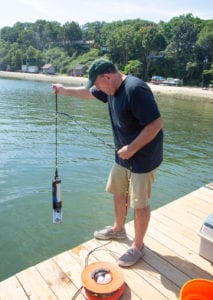
George Hoffman, co-founder of Setauket Harbor Task Force, said the organization participated in Shell Day Aug. 22 when the group tested water from the Village of Poquott’s new dock. Shell Day is a six-state water monitoring event coordinated by Northeast Coastal Acidification Network. NECAN, which serves as an interface between research and industry interests, enlisted 50 water quality groups run by citizen scientists to test for levels of ocean acidification along the harbors and bays from Maine to the Long Island Sound.
Covering more than 600 miles of the U.S. Northeast coast, the testing will give scientists a broader picture of the extent of acidification that comes into the ocean from harbors and bays.
“[Acidification] is having impacts on shellfish and baby fish,” Hoffman said. “The problem with a higher acid content of the water is that it starts to impact the shell of the baby shellfish as they are emerging. It weakens the shells and makes them more susceptible to die-offs, and they don’t survive. It’s just impacts the whole food chain.”
Hoffman said the task force tests water conditions in the Sound’s bays and harbors twice a year and was thrilled to participate in Shell Day. The Village of Poquott was the ideal spot for the testing, he said, due to its new dock in the middle of Port Jefferson Harbor, and the task force appreciated village officials allowing them to use the location.
Testing was done during three phases of the tide — low, mid and high — which took place at 11:18 a.m., 2:18 p.m. and 5:30 p.m. Hoffman said two water samples were taken from every phase of the tide and then put on ice. The samples were then sent by ferry to Bridgeport, Connecticut, where they will be analyzed at the University of Connecticut’s laboratory for alkalinity and salinity.
Poquott Mayor Dee Parrish said in an email the village was pleased that the dock, which was officially opened in June, was chosen. While the goal was to provide a place for residents to use for fishing, photography, summer lounging and social interactions, the testing on the dock was a first.
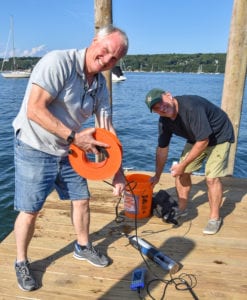
“Being able to assist the Setauket Harbor Task Force in obtaining the water samples that will provide actionable information for watershed management, strategic habitat protection and restoration is a really fabulous end of season way to celebrate our first year with this wonderful new community asset,” Parrish said.
Laurie Vetere, president of the Setauket Harbor Task Force, said in a statement that the group is eager to participate in every study that can determine the health of Port Jefferson and Setauket harbors
“We hope that our efforts on Shell Day 2019 will drive the local and regional governments to step up their efforts to improve the ability of our local waters to provide optimal habitats for our native and dwindling marine life,” Vetere said.
State Assemblyman Steve Englebright (D-Setauket), chair of the state’s Assembly Committee on Environmental Conservation, applauded the group’s efforts in a statement. Englebright is responsible for drafting legislation to establish Stony Brook University’s Ocean Acidification Task Force.
“The process of ocean acidification is invisible, and we need to have regional scientific datasets to bring the magnitude of this enormous threat to marine life into plain site and help us develop strategies to address its impacts,” Englebright said. “Time and again, we see that ordinary citizens are ready and willing to help with critical scientific data collection. Shell Day 2019 is a powerful and inspiring example of how we can bring citizen scientists together with leading government agencies to make a real difference.”
‘Butterflies … flowers that fly and all but sing.’ − Robert Frost
Bill Pollack of East Setauket snapped this stunning photo in his backyard with a Samsung Galaxy S9 on Aug. 8. He writes, ‘This [eastern tiger swallowtail] butterfly stopped by for a little nectar from my hanging plant.’
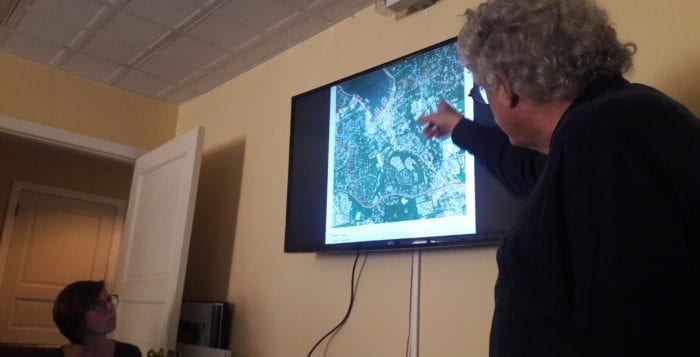
If Port Jefferson experiences another “100 year flood” sooner than a century, then at least it knows where the water is coming from.
Professionals from Port Jefferson-based Campani and Schwarting Architects attended the Aug. 19 village meeting showing map after map of where the problem areas for Port Jeff flooding are, and offered suggestions, some big and some small, of how to combat the issue of flooding.
Michael Schwarting said many of the issues are due to an excess of hardscape, both building roofs and roads, and a significant lack of permeable spaces, especially in areas where the depth of the water table is less than 11 feet below ground. Forty percent of village property is non-water-permeable.
“There’s a fair density of buildings that contribute to the groundwater conditions,” he said. “That contributes in bringing water from the watershed to the lowest point.”
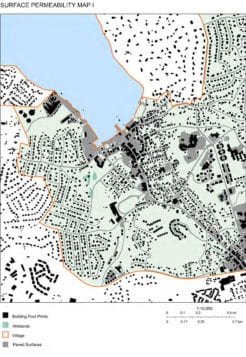
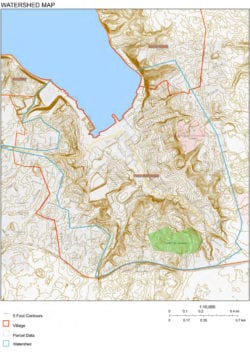
In the three-square-mile village, with a population of just over 8,000, the vast majority of land sits within the Port Jefferson watershed area.
The village tapped the PJ-based architectural firm back in February to construct a water management and storm surge study. While the study still needs to be finalized, with map after map, the architect discussed numerous issues contributing to flooding. One such map described how there were numerous roads that sloped down toward Port Jefferson Harbor. Some roads house catch basins to collect the water before it reaches trouble points, some streets have too few or no catch basins while others had more than is likely necessary.
Last September, Port Jefferson was bowled over with water, with nearly 4 inches of rain collected in a short span of time. Buildings like the Port Jefferson firehouse and the venerable Theatre Three were drowned in 3 to 4 feet of water, causing thousands of dollars in damages in the case of the theater.
The architect said what is likely a major cause of this is due to piping systems that draw a lot of water to the end of Barnum Avenue and the driveway to the Port Jefferson high school. Schwarting added there are stories of when that pipe was being built, children used to walk to school along it, meaning the system sits close to the surface.
“All of these pipes, some coming from North Country Road to Main Street with a lot of catch basins are contributing to this one point at Barnum and high school,” he said.
Mayor Margot Garant said they have received a report from Bohemia-based engineering firm P.W. Grosser Consulting about the pipe running from that culvert to the outfall pipe behind village hall. That report said there was sediment buildup at a low point in the pipe, also showing the pipe had “a pinch and a jog” that leads down toward the harbor.
In June, Port Jefferson Village presented its Waterfront Revitalization Plan to the Long Island Regional Economic Development Council, describing its intention to perform immediately needed maintenance of the storm drainage system and provide emergency equipment to deploy in a rain event to protect properties in the village in catastrophic flooding.
At its July 15 meeting, the village voted unanimously to apply for grant funds not to exceed $1 million from the state Division of Planning’s Local Waterfront Revitalization Program, Empire State Development and any other applicable state agencies.
The architects point out numerous small projects that can be done around the village to aid in flood mitigation, mostly in increasing permeable surfaces around the village. This would include rain gardens and bioswales, a landscape element designed to concentrate or remove debris and pollution out of surface runoff water, permeable paving systems, tree trenches and bioretention planters, acting as plant bed medians with grooves cut in the curb allowing water to drain in and flow into local outlets.
Though the architectural firm also endorsed several major projects, such as “daylighting” Mill Creek and the firm’s own plan proposal, given to the village in 2013, to completely remake the Brookhaven Town parking lot and boat ramp, adding significantly more greenery and passive recreational space in what is now hardscape.

Scientists have discovered natural wonders in a Setauket forest.
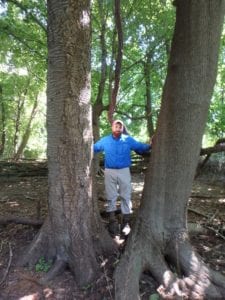
Researchers from the State University of New York College of Environmental Science and Forestry took to the 43-acre woods of Patriots Hollow State Forest, along Route 25A, across from Stop & Shop, to collect information on the forest composition and structure Aug. 8 and 9. The researchers hoped to develop management recommendations that would enhance the forest for biodiversity conservation and environmental education. The survey was funded by a grant from Avalon Park & Preserve, according to a press release from Three Village Community Trust.
In 2018, the community trust set up a steering committee led by Setauket resident and former teacher Leonard Carolan to clean up the woods and add a trail for people to walk through the forest, something which is currently difficult with downed trees and invasive plants, including Norway maple, Japanese aralia, Oriental bittersweet, black locust and Japanese stiltgrass.
After Carolan approached the New York State Department of Environmental Conservation and state Assemblyman Steve Englebright (D-Setauket) to seek help in cleaning up the forest, the community trust signed a stewardship agreement with the DEC. Carolan said the initial reports are encouraging.
“It looks like we’ll be able to restore it to an original native forest,” Carolan said.
He added that, in the future, there would be a loop trail near Route 25A and another one near the Main Street section, but before they are created some cleanup needs to be done and funds raised, which could take years.
Don Leopold, distinguished teaching professor from SUNY-ESF’s Department of Environmental and Forest Biology, along with research assistant Samuel Quinn, was among the researchers.
Leopold said it was his first visit to the forest, and he was impressed with the findings. Despite invasive plants and past agriculture that didn’t leave many remnant trees, he said they discovered many beautiful oak and hickory trees, adding that he had seen black oak and sassafras all over the Eastern United States, and amongst the largest he has seen were in Patriots Hollow.
“We went by some really great trees,” he said. “Ideally the trails will swing by those. They can’t miss these. There are really impressive specimens of some black oaks and some hickories, and we really enjoyed seeing them.”
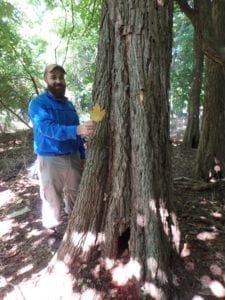
The researcher said they also found spicebush in the forest.
“Spicebush is one of our most important native shrubs,” Leopold said. “It’s so important for wildlife coming for food. It’s a source of food for the spicebush swallowtail [butterfly].”
Leopold and Quinn discussed management of invasive plants in the forest with Bill Jacobs, Luke Gervase and Caroline Schnabl of Long Island Invasive Species Management Area who joined in the survey. Leopold said that they are optimistic that the invasives could be eliminated, which is vital for the growth of new trees.
Leopold added that a male box turtle, approximately 30 years old, was found in the wooded area. He said the species can live to be more than 100 years old, and the one they saw in Patriots Hollow reminded him a pumpkin with legs, as it was especially big and colorful.
The researcher said they encountered tick bombs while in the forest, with 100 to 200 small tick larvae starting to disperse at one time. He said when the lone star ticks are older their bites can cause problems as they can carry a disease that makes a person allergic to red meat.
“Until there are trails, and until some of these issues are addressed, it would be good to not have a bunch of folks running through here because the tick infestation can be a public health hazard,” he said.
Brian Leydet of SUNY-ESF will analyze ticks collected during the survey so recommendations can be made to the community trust and DEC about ways to reduce human-to-tick contact.
The 3VCT’s steering committee will look to include the community in the planning process and will work with the trust itself to seek grants and contributions. The initial implementation of the restoration and management plan will be funded by a grant of $500,000 secured by state Sen. John Flanagan (R-East Northport) in 2018, according to a press release from the trust.
